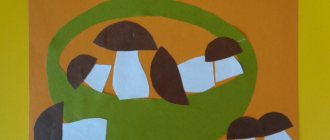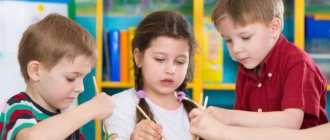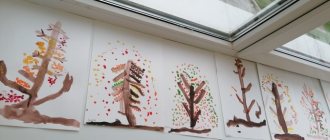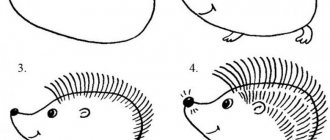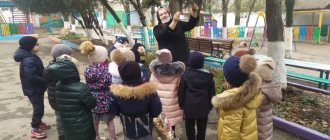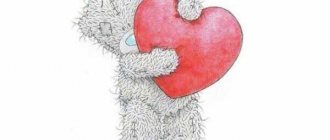Features of the middle group
In the activities of four-year-old children, an important place is occupied by teaching correct behavior at home and in public places. At the same time, they develop organization and responsibility. Teachers explain to children what to do in certain situations and what not to do. During classes and in free activities, the teacher works to develop the creative abilities of pupils in the middle group of the kindergarten.
Middle group of kindergarten: image of a pupil
At this age the child is fully formed. Each has its own character, certain preferences and tastes. Four-year-old children are very active and want to make many friends. Often their activity confuses not only educators, but also parents. Children of four years old practically conquer one height after another. Today it was the back of the sofa, tomorrow it was the window sill, then a heated towel rail in the bathroom, a computer desk. Children want to explore everything. Often such actions are destructive. It is at such moments that many parents begin to send their children to kindergarten groups, where the children’s activities are filled with communication with peers and a variety of activities in which they can release their energy.
Specialized groups
The division of children in preschool educational institutions is carried out not only by age, but also by purpose and nature of stay.
The mental characteristics and physiological state of the child are also taken into account. Today, the following specialized groups operate in Russian kindergartens:
- GKP or short-term stay . They are rare in preschool educational institutions. They are intended for those children whose parents are not yet ready to leave for the whole day. As a rule, such a group includes no more than 15 people. This allows you to implement an individual approach to the development of the baby. In some kindergartens, the GKP is combined with a regular group;
- speech therapy Suitable for children who have problems with pronunciation. Speech therapists work with the children. The purpose of the classes is to correct speech defects and enrich vocabulary;
- for children with disabilities . The group is distinguished by its heterogeneity. It is attended by children with visual and hearing impairments, and problems with the musculoskeletal system. Children with developmental delays and various emotional disorders are also included here. Specialists work with children to help them eliminate the disorder and acquire the necessary level of knowledge;
- summer _ This is a multi-age temporary group of preschool educational institutions. Created for the summer. The emphasis is on entertainment rather than education. Hiking, outdoor games, and excursions are organized for children.
Math classes
Various activities are organized for all kindergarten students. If we talk about mathematics, it can be noted that in the younger group, educators give children basic knowledge in this area, while the middle group assumes the complication of tasks in the formation of elementary mathematical concepts. Mathematics classes include learning to distinguish the constituent parts of a certain group of objects and the formation of concepts of similarities and differences between them. The teacher develops knowledge that a group of objects is larger than the individual thing that is part of it. Already at this age, children are taught to count to ten.
Short stay group (STG)
As a rule, very young children from 1 to 3 years old are enrolled in the short-stay group. This service can be used by any interested parent who has submitted the necessary documents and joined the queue. Such groups work 3 times a week for 3 hours in total.
Classes there start at 8:30 and last until 11:30. There is also an evening shift from 16:00 to 19:00. It all depends on the schedule of classes at the educational institution, so always check the opening hours at your garden.
Note to parents
Most often, parents worry about at what age to send their child to kindergarten and whether it is worth doing it so early, because children from 1 to 3 years old still need their mother’s presence. It is especially difficult for parents to make a decision if this is the first baby in the family.
Staying in kindergarten is the very first and most important experience for every child. Here he learns to show his personal qualities and communicate with peers.
If we omit the details, the opinion of many experts agree on one thing: from a psychological point of view, meeting and communicating with children in a playful and relaxed manner helps the child adapt and enter society. After all, in this society the child will grow and develop, gain experience and experience different stages of personality development. And the sooner the child begins to adapt, the better it will be for his psychological health.
It should be noted that young mothers and fathers should also be prepared for such a responsible step.
And before you send your child to a short-stay group, make sure that this is exactly the place where your son or daughter will be comfortable.
Today you can quickly find reviews on the Internet about any product or service. Look for reviews and comments about your kindergarten. And you probably know mothers whose children also go to this kindergarten. You can also come to the kindergarten and see everything with your own eyes, and chat with the nannies and teachers.
What activities are conducted with children in short-stay groups?
Typically, such groups have 2 classes a week of physical education and music and once a week classes in drawing, modeling, literature and design.
It’s also not difficult to sign up for GKP groups. They are available in almost all preschool institutions. To be included in the group, you must:
- contact the head of the kindergarten with a request to enroll the child in the GKP. If there are places in the group, you will definitely be accepted;
- if there are no free places, contact the so-called “Mini-OSIP” (this is the district information support service).
- You can also sign up for the group through the city services portal
When you have found a place, you need to worry about documents for the garden. There are not many of them, but you will have to collect them quickly:
- passport of the parent or legal representative of the child;
- baby's birth certificate;
- child registration in the city;
- if you have benefits, also provide a document for inclusion in the preferential category;
Enrollment in the GKP occurs in the same way as in a regular kindergarten group. You are put on a waiting list and when a place becomes available, they call you and inform you that your child can go to kindergarten.
Procedure for enrollment in a short-stay group.
When there are few free places in a group, the head of the kindergarten must follow certain rules when enrolling a child in the group. For example, your child will be accepted faster if:
- your family (or child) lives/is registered in this area;
- preferential categories of children
If all children from this list are enrolled, then in order of priority the following are enrolled:
- children with temporary registration
- kids from other areas
A parent does not have to go to the daycare every week or month to find out if a place has become available. Typically, parents are sent an email notification or receive a call on their cell phone.
When enrolling in kindergarten, check the availability of a medical card, and immediately before enrollment you must provide:
- contacts of the child and his parents;
- complete blood count and urine test;
- analysis for enterobiasis and worm eggs
Before enrolling a child in a kindergarten group, the parent will have to sign a service agreement, which will spell out all the rights and responsibilities of both parents and teachers.
As a rule, documents of this kind protect both parties from possible claims. Therefore, every parent should not be lazy and read this agreement carefully.
Features of children staying in a short-term group
The child is not in kindergarten all day, but only for some part of the day, so meals are not provided here. But any baby can freely ask for water. So before you send your son or daughter to kindergarten, don't forget to feed him.
Adaptation in the group is quite smooth. Any parent can go to the group and see how their child feels there. This makes it easier for the baby to survive a long separation from his parents and get comfortable in a new environment. Remember also that the child’s psyche is quite vulnerable at this age, and any innovation can have a bad effect on his emotional state. But if you prepare your baby and send him to a short-term group, you can avoid negative emotions on the part of the baby.
The first days in the GKP last only half an hour for a child. Then the stay time becomes longer, but it all depends on the child’s behavior and addiction. Often educators recommend starting with half an hour and adding only 15 minutes every few days so as not to escalate the situation.
Approximate schedule for short-stay groups:
- Monday - 9:00-9:10 music games; 10:10-10:20 didactic games;
- Tuesday—10:00-10:10 movement development, 10:30-10:40—artistic creativity (drawing, modeling, appliqué, coloring must alternate here);
- Wednesday—9:00-9:10 didactic game, 10:00-10:10 speech development;
- Thursday—9:00-9:10 outdoor game; 10:00-10:10 games with building materials;
- Friday—9:10-9:20 educational game; 10:00-10:10 music game
The average monthly cost of GKP is about 1,500 rubles. However, if you have benefits, you can write an application for payment compensation (or part of the compensation).
What additional expenses does the parent expect?
Many kindergartens and groups also have additional expenses, which most often depend on the director of the kindergarten. This point should also be discussed in advance, and it is best to do this at the time of signing the contract with the garden. Although, the times when huge gatherings were held in gardens are long gone.
However, some parents face actual extortion. In this case, you should contact the anti-corruption hotline.
Speech development
The middle group of kindergarten involves planning the activities of the teacher in such a way as to give children basic knowledge of sounds and syllables, as well as sentences. In stories from personal experience, children are encouraged to use not only direct but also indirect speech. Attention is paid to ensuring that children actively use different types of complex sentences when communicating. The middle group of kindergarten involves developing skills in retelling literary works with simple plots.
Development of coherent and clear speech
- Correctly and clearly articulates the sounds of his native language. There may be some difficulties in pronouncing some complex sounds, such as hissing. Also, some children do not pronounce “l” and “r” clearly.
- Knowledge of singular and plural numbers. The ability to generalize objects into groups and voice their common name: dolls and cubes - toys, spoons and mugs - dishes, table and chair - furniture and so on.
- Compose competent sentences and small coherent texts.
- Make retellings, as well as descriptions of pictures and objects.
- Answer the teacher’s questions about the work you read.
- Know short children's poems by heart.
Educational, developmental and training tasks
The functions of a preschool teacher are varied. Among the main ones I would like to note is ensuring the physical development of children. The teacher must promptly teach children to perform basic movements. Particular attention is paid to the formation of basic cultural and hygienic skills. The middle group of kindergarten assumes a daily routine that harmoniously fits the tasks of developing the cognitive activity of pupils. The work of a teacher involves expanding children's knowledge about people, phenomena and objects. He also teaches how to identify the features of objects through sensory examination, elementary analysis and comparison.
What does a teacher teach four-year-old children?
Pupils of the middle group develop independence skills. Classes are conducted to teach them different ways of doing things. Self-service skills are gradually developed in children. Particular attention is paid to teaching game actions. All tasks can be found in the program by finding the “Middle Group” section there. Games are presented in blocks. It is indicated which of them need to be planned during physical education classes, which ones - during a walk and during free activity. Manual labor also occupies an important place in the middle group of kindergarten. During its organization, the teacher solves many educational, developmental and educational tasks. Such activities contribute to the formation of a friendly atmosphere in the team. Manual labor in the middle group is attractive to children because it provides an opportunity to show individuality and creativity. Speech development classes are organized according to a program appropriate for a given age group. Teachers also formulate children’s ideas about a healthy lifestyle. The program for a kindergarten involves planning the activities of the teacher in such a way that it contributes to the full development of each pupil. This is possible due to compliance with the regime, which is compiled for the middle group, taking into account the characteristics of its pupils.
Age features of development of children 4-5 years old (middle group)
Age features of development of children 4-5 years old (middle group)
A 4-5 year old child has an idea of how he should (shouldn’t) behave and the peculiarities of sexual behavior. What stands out in the behavior of his peers and his own is his non-compliance with norms and rules. He gets emotional when he doesn’t act “as he should.” Children's mutual control over each other's behavior increases. Without an adult’s reminder, he is able to put away toys, perform work duties, and complete work. However, during the activity itself, he may be distracted by more interesting activities. In interactions with others, he exhibits (but not always) socially approved forms of behavior.
Educational field "physical development"
The “Physical Development” direction includes two educational areas: “Health” and “Physical Education”.
The content of the educational field “Health” is aimed at achieving the protection of children’s health and forming the basis of a culture of health through solving the following tasks:
• maintaining and strengthening the physical and mental health of children;
• education of cultural and hygienic skills;
• formation of initial ideas about a healthy lifestyle.
The content of the educational field “Physical Education” is aimed at achieving the goals of developing children’s interest in physical education, harmonious physical development through solving problems:
• development of physical qualities (speed, strength, flexibility, endurance, coordination);
• accumulation and enrichment of children's motor experience (mastery of basic movements);
• developing in pupils the need for physical activity and physical improvement[2].
In all forms of organizing motor activity, it is necessary not only to form children’s motor skills and abilities, but also to cultivate purposefulness, independence, initiative, and develop the ability to maintain friendly relationships with peers.
In the fifth year of life, the child’s movements become more confident and coordinated. Attention becomes more and more stable, visual, auditory and tactile perception improves, and targeted memorization develops. Children are already able to distinguish between different types of movements and identify their elements. They develop an interest in the results of the movement and the need to perform it in accordance with the model. All this allows you to begin learning the technique of performing basic movements and developing their quality. The knowledge gained in classes about the importance of physical exercise for the human body helps to cultivate the need to be healthy and lead a healthy lifestyle. Teachers need to continue the work begun in the younger group to improve children’s health. To do this, it is necessary to carry out daily: walks in the air in accordance with the daily routine, a set of hardening procedures; morning exercises lasting 6-8 minutes.
The main form of systematic teaching of physical exercises to children is integrated activity, which consists of three parts: introductory, main and final. In each of them, a certain level of development of the child’s integrative qualities is achieved. Duration - 20-25 minutes.
In the middle group, three physical education activities are held per week, one of them is a walk. The duration of each part increases compared to the previous year due to the complexity of the exercises, the development of movement techniques and the increase in execution time.
By the end of the fifth year, children can:
• walk and run, observing the correct technique of movements;
• climb the gymnastic wall without missing the slats, climbing from one flight to another; crawl in different ways: leaning on your hands, knees and toes, on your feet and palms; on your stomach, pulling yourself up with your arms;
• take the correct starting position when jumping from a place, land softly, and long jump from a place to a distance of at least 70 cm;
• catch the ball with your hands from a distance of up to 1.5 m; take the correct starting position when throwing, throw objects in different ways with the right and left hand; hit the ball on the ground (floor) at least five times in a row;
• perform exercises for static and dynamic balance;
• line up in a column one at a time, in pairs, in a circle, in a line;
• slide independently along ice paths (length 5 m);
• ski at a sliding step for a distance of up to 500 m, perform a turn by stepping, climb a hill;
• ride a two-wheeled bicycle, make turns right and left;
• navigate in space, find the left and right sides;
• come up with options for outdoor games, perform movements independently and creatively;
• perform simulation exercises, demonstrating beauty, expressiveness, grace, and plasticity of movements.
Mastering and improving abilities and skills in basic types of movements, outdoor games and sports exercises should be provided for in all forms of work organized by the teacher: in physical education classes, on a morning walk, during individual work on an evening walk.
Educational field "Social and communicative development"
Work
The main goal of labor education in preschool age is the formation of a positive attitude towards work. The implementation of this goal is carried out through solving the following tasks:
— familiarization with the work of adults, the formation of ideas about the social significance of work and instilling respect for people who work, as well as a careful attitude towards its results;
— organization of children’s work activities, during which work skills, work organization skills are formed, as well as positive relationships between the child and adults and peers.
At the end of the year, children can:
• treat your clothes with care, be able to put them in order;
• independently maintain order in the premises and area of the kindergarten;
• care for birds and plants in the group room and on the site;
• independently clean your workplace after finishing classes and perform the duties of cafeteria attendants.
Safety
The main direction is the formation of the foundations for the life safety of preschool children, as well as the formation in them of the foundations for the safety of the surrounding world (ecological consciousness).
This process occurs through solving the following tasks:
• formation of ideas about situations dangerous to humans and nature;
• developing a prudent and cautious attitude towards dangerous situations in a person’s life;
• introduction to the rules of safe behavior at home, on the street and in nature;
• formation of knowledge about the Rules of the Road.
To organize training of preschoolers in traffic rules, it is necessary to create special conditions in preschool educational institutions for the construction of a subject-development environment, which can be represented by the following components:
• Toys and play equipment:
transport: bus, train and railway, cars, trucks, fire truck, ambulance, police car; dolls, strollers; wooden constructor; dolls: traffic light, traffic police inspector, child, bibabo theater, animals. Director's game: the playing field is the road. “Road in a fairy-tale forest” (heroes from fairy tales, signs).
• Visual and didactic aids:
public transport: tram, trolleybus, bus, metro, minibus, taxi, train and railway, cars, trucks; paintings: depicting a city street (with signs and traffic lights); intersection with a traffic police inspector; a picture depicting a roadway (with cars), a sidewalk (with people); 10x15 cards depicting different situations on the road: ball games on the road; people crossing a pedestrian crossing, people crossing an underground passage; road signs: “Pedestrian crossing”, “Underpass”, “Caution, children”, “Two-way traffic”. Punch cards - A3 with different situations in the file. Layout on a table (or fabric wall, road - cars, people). Labyrinth "Journey through the city", a road with signs and small cars. Algori, “Beware of the road,” “Find a pedestrian crossing.”
• Attributes
for
role-playing games:
aprons or hats with signs (4); traffic light, intersection on the floor (from any material) with a zebra crossing and a traffic island. Attributes for a traffic police inspector. Driver's cap, steering wheels; on cardboard - public transport: bus, train, car; models of houses, public buildings, road signs.
• Didactic games:
“Guess what you’ll be lucky in”, “Right - wrong”, “Allowed - forbidden”, “Road field”.
• Safe routes from kindergarten to home.
Content
educational field “Safety” is presented for all participants in the educational process of preschool educational institutions: children - teacher - parents.
By the end
of the year, children
can:
• master the skills of safe behavior in outdoor and sports games;
• use sports and garden equipment taking into account safety rules;
• know the rules of safe behavior and movement indoors, outdoors and in transport.
At the end of the year, a child in the middle group may know:
• Low level. Knows what kind of transport is moving on the road. Knows its parts; knows how to navigate in space. Knows the purpose of traffic lights in general.
• Average level. Knows what kind of transport moves on the road (roadway) and railway. Knows the components of transport. Familiar with the work of a driver and driver. Knows about the rules of conduct on the roadway, on the sidewalk, on the street, in transport; on a winter road, knows the purpose of each traffic light color.
• High level. It is oriented in that cars move along the roadway, and pedestrians walk along the sidewalk. Knows the purpose of the traffic light and all its signals, orients himself well in space. Has an idea of types of transport and the peculiarities of their movement. Has an idea of the purpose of specialized transport: fire truck, police car, ambulance. Knows how to behave correctly in all types of public transport. Knows what rules of safe behavior must be followed on the road. It is oriented in that the movement of cars can be one-way or two-way, and the roadway of the street in two-way traffic can be divided by a line. Knows that there is a “safety island” on the road and has an idea of its purpose. He knows what city he lives in and what his address is. Knows the safe way from kindergarten to home. Focused on the fact that there are many road signs on the roads. Knows and explains the purpose of such road signs as “Pedestrian crossing”, “Underground crossing”, “Overground crossing”, “Two-way traffic”, “Children”.
COGNITIVE DEVELOPMENT
FORMATION OF ELEMENTARY MATHEMATICAL CONCEPTS
The section “Formation of elementary mathematical concepts” is one of the components of the content of the educational area “Cognition”. The development of elementary mathematical concepts is of great importance in the mental education of children.
The goal of the elementary mathematics program is to develop methods of mental activity, creative and variable thinking based on attracting children's attention to the quantitative relationships of objects and phenomena in the world around them. The goal is achieved through solving the following tasks:
- formation of an idea of the number of objects of different colors, sizes, shapes;
— development of the ability to determine the equality or inequality of parts of a set;
- development of the ability to count objects from a large number (based on clarity);
— improving the ability to compare objects by size;
— expansion of ideas about geometric shapes;
— development of the ability to navigate in space and time.
A condition for the successful implementation of a program in elementary mathematics is the organization of a special subject-development environment in groups in the kindergarten area for direct action of children with specially selected groups of objects and materials in the process of mastering mathematical content.
In the average group, the duration of the lesson is 15-20 minutes. Didactic games are widely used in the learning process.
By the end of the year, five-year-old children can:
• distinguish what parts a group of objects is made of, name their characteristic features (color, shape, size);
• count to 5 (quantitative counting), answer the question “How many in total?”;
• compare two groups by individually correlating objects (making pairs);
• arrange 3-5 objects of various sizes (length, width, height) in ascending (descending) order; talk about the size of each item in the row;
• distinguish and name triangle, circle, square, rectangle; ball, cube, cylinder; know their characteristic differences;
• find objects in the environment that are similar to familiar figures;
• determine the direction of movement from yourself (right, left, forward, backward, up, down);
• distinguish between left and right hands;
• identify parts of the day.
Educational field "Speech development"
Development of productive activities: drawing, modeling, appliqué,
artistic work"
The content of the educational field “Artistic Creativity” is aimed at developing interest in the aesthetic side of the surrounding reality and satisfying the needs of preschool children for self-expression.
The main objectives of artistic and aesthetic development are:
— development of children’s productive activities (drawing, modeling, appliqué, artistic work);
— development of children's creativity;
- introduction to fine arts[4].
For children to successfully master visual arts and develop their creativity, it is necessary to remember the conditions common to all age groups.
1. Formation of sensory processes, enrichment of sensory experience, clarification and expansion of ideas about those objects, objects and phenomena that they are to depict.
2. Taking into account the individual characteristics of children, their desires and interests.
3. The use of children's works in the design of kindergarten premises, the organization of various exhibitions, as well as gifts for children and adults. Preschoolers should feel: their drawings, modeling, and appliqué arouse the interest of adults, they need them, and can decorate the kindergarten, apartment, or house where they live.
4. A variety of topics for children’s work, forms of organizing classes (creation of individual and collective compositions), and artistic materials.
5. Creating a creative, friendly environment in the group, in visual arts classes and in free artistic activities. Respect for children's creativity.
6. Taking into account national and regional characteristics when selecting content for drawing, modeling, and appliqué classes.
One of the important tasks of artistic and creative activity is to teach children to evaluate their own works and the works of their peers, to highlight the most interesting visual solutions in the works of others, to express aesthetic assessments and judgments, and to strive for meaningful communication related to visual activities.
By the end of the year, children can:
• highlight the expressive means of Dymkovo and Filimonov toys, show interest in book illustrations.
In drawing
• depict objects and phenomena, using the ability to convey them expressively by creating distinct forms, choosing colors, carefully painting, using different materials: pencils, paints (gouache), felt-tip pens, colored greasy crayons, etc.;
• convey a simple plot by combining several objects in a drawing, placing them on the sheet in accordance with the content of the plot;
decorate the silhouettes of toys with elements of Dymkovo and Filimonov painting. Introduce Gorodets products. Develop the ability to identify elements of Gorodets
paintings (buds, flowers, roses, leaves); see, name the colors used in painting.
In sculpting
• create images of different objects and toys, combine them into a collective composition; use all the variety of learned techniques.
In the application
• hold the scissors correctly and cut with them in a straight line, diagonally (square and rectangle), cut a circle from a square, an oval from a rectangle, smoothly cut and round the corners;
• carefully paste images of objects consisting of several parts;
• select colors in accordance with the color of objects or at your own request;
• make patterns from plant shapes and geometric shapes.
Working with parents
Contents of areas of work with families in educational areas:
Educational field “physical development”:
— informing parents about factors affecting the child’s physical health (calm communication, nutrition, hardening, movement).
- attracting parents to participate in joint physical education holidays and other events with their children).
Educational field “socio-communicative development”:
- familiarizing parents with situations dangerous to the child’s health (at home, in the country, on the road, in the forest, near a pond) and how to behave in them.
— to interest parents in the development of children’s play activities, ensuring successful socialization and assimilation of gender behavior.
— study the traditions of labor education in the families of pupils.
Educational field “cognitive development”:
— orient parents towards the development of the child’s need for cognition and communication with adults and peers.
Educational field “speech development”:
— develop parents’ communication skills using family assemblies and communication trainings.
— prove to parents the value of reading at home.
Educational field "Artistic and aesthetic development":
— support the desire of parents to develop the artistic activities of children in kindergarten and at home.
— to reveal the possibilities of music as a means of beneficial effects on the mental health of a child.
Results of mastering the program
1. Integrative quality “Physically developed”, having mastered basic cultural and hygienic skills:
—
anthropometric indicators: height, weight;
— independently performs available hygiene procedures;
— knows about the benefits of morning exercises and exercise.
2. Integrative quality«
Curious, active." Shows curiosity, interest in research and experimentation.
3. Integrative quality “Emotionally responsive”:
- responds to the emotions of loved ones and friends;
- empathizes with the characters of fairy tales, stories, stories;
- reacts emotionally to works of fine art, music and art, and the natural world.
4. Integrative quality “Mastered the means of communication and ways of interacting with adults and peers”:
- knows how to select objects and attributes for role-playing games;
- can take initiative in helping comrades and adults.
5. Integrative quality “Able to manage one’s behavior and plan one’s actions based on primary value concepts, observing basic generally accepted norms and rules of behavior”:
- knows how to plan a sequence of actions;
- knows how to follow the rules of the game;
- independently or after a reminder from an adult, uses “polite” words in communication.
6. Integrative quality “Able to solve intellectual and personal tasks (problems) that are age-appropriate”:
- has basic self-service skills;
- navigates the space of the kindergarten;
- takes initiative in choosing the role of the plot in theatrical games;
- knows how to independently find interesting activities for himself.
7. Integrative quality “Having primary ideas about oneself, family, society, state, world and nature.”
- knows his first and last name, age, names of his family members;
- can talk about his hometown, name it;
- knows some public holidays;
8. Integrative quality “Mastered the universal prerequisites of educational activity”:
— carries out individual and collective assignments;
- can describe an object, a picture, retell an excerpt from a fairy tale;
- able to act with concentration for 15-20 minutes.
9. Integrative quality “Having mastered the necessary skills and abilities.” The child has developed the skills and abilities necessary to carry out various types of children's activities.
Age characteristics of the development of children 4-5 years old according to the program “From birth to school”
Educator:
Barannikova M. G.
Dimenyuk E. S.
Atmosphere in the middle group of kindergarten
Among the tasks that the teacher solves, a special place is occupied by the development of relationships between four-year-old children. He teaches them to coordinate actions, accept a common goal and strictly follow it. The teacher makes sure that every child is able to experience joy from the results of joint activities and treat everything around him kindly. It teaches kids to respond emotionally to the states of other people and to show kind feelings towards plants and animals. In the course of joint activities, the teacher develops children’s creative expressions and fosters interest in participating in various games. He also encourages students to engage in artistic activities, teaches them to experience success and joy from the fact that they managed to realize their plans.
Getting to know the world around you
- Knows the shapes, sizes and materials of objects.
- Knows the basic objects that surround him in everyday life: furniture, dishes, clothes, shoes, toys, food, plants, vehicles.
- Knows the body parts of humans and animals.
- Knows the locality where he lives.
- Possesses basic skills of traffic rules: pedestrian crossing, green and red traffic lights.
How the development environment is organized
For the full development of four-year-old children, social, social, spiritual and material conditions are provided. The right equipment is essential to encourage children to engage in playful activities and develop their imagination. The subject environment can be compared to mental activity, which is why it is so important for the comprehensive development of the personality of each child. The subject environment represents the external conditions of the pedagogical process, makes it possible to properly organize the independent activities of students and contributes to their self-development under the supervision of a teacher.
